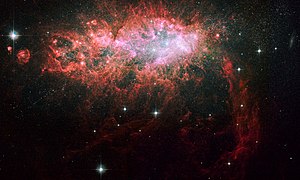NGC 1569
| NGC 1569 | |
|---|---|

|
|
| Observation data (J2000 epoch) | |
| Constellation | Camelopardalis |
| Right ascension | 4h 30m 49.1s |
| Declination | +64° 50′ 53″ |
| Redshift | -104 km/s |
| Distance | 10.96 ± 0.65 Mly (3.36 ± 0.20 Mpc) |
| Apparent magnitude (V) | 11.9 |
| Characteristics | |
| Type | IBm |
| Apparent size (V) | 3′.6 × 1′.8 |
| Notable features | Contains two super star clusters |
| Other designations | |
| VII Zw 016,Arp 210 | |
The NGC 1569 is a dwarf irregular galaxy in Camelopardalis. The galaxy is relatively nearby. Consequently, the Hubble Space Telescope can easily resolve the stars within the galaxy. The distance to the galaxy was previously believed to be only 2.4 Mpc (7.8 Mly). However, in 2008 scientists studying images from Hubble calculated the galaxy's distance at nearly 11 million light-years away, about 4 million light-years farther than previous thought: therefore the galaxy resulted to be a member of the IC 342 group of galaxies.
NGC 1569 is smaller than the Small Magellanic Cloud, but brighter than the latter or the Large Magellanic Cloud
NGC 1569 is characterized by a large starburst. It has formed stars at a rate 100 times greater than that of the Milky Way during the last 100 million years. It contains two prominent super star clusters with different histories. Both clusters have experienced episodic star formation. Super star cluster A, located in the northwest of the galaxy and actually formed of two close clusters (NGC 1569 A1 and NGC 1569 A2), contains young stars (including Wolf-Rayet stars) that formed less than 5 million years ago (in NGC 1569 A1) as well as older red stars (in NGC 1569 A2). Super star cluster B, located near the center of the galaxy, contains an older stellar population of red giants and red supergiants. Both of these star clusters are thought to have masses equivalent to the masses of the globular clusters in the Milky Way (approximately (6-7) × 105solar masses). Numerous smaller star clusters, some of them having masses similar to those of small globular clusters or R136 in the Large Magellanic Cloud, with relatively young ages (between 2 million years and 1 billion years) have also been identified. These results, along with the results from other dwarf galaxies such as the Large Magellanic Cloud and NGC 1705, demonstrate that star formation in dwarf galaxies does not occur continuously but instead occurs in a series of short, nearly instantaneous bursts.
...
Wikipedia
